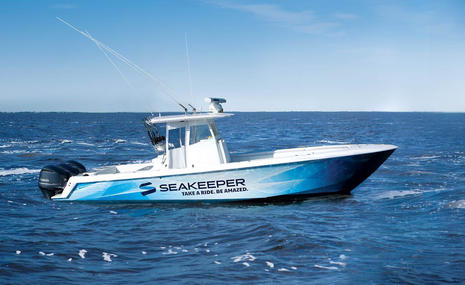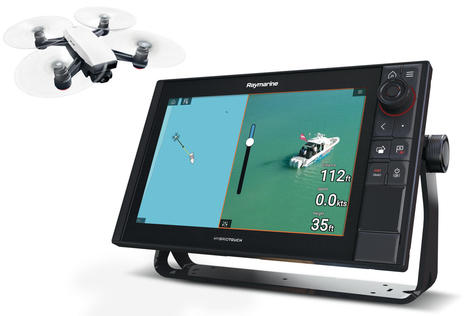Data bridging, a good thing

It may seem nuts that the Raymarine E-Series can input/output data via good old NMEA 0183, SeaTalk (Ray’s proprietary improvement on 0183), SeaTalk2 (actually NMEA 2000), and SeaTalk HS (actually Ethernet)…but it’s a darn good data architecture. For one thing, there are situations where every one one of those protocols will be used to usefully shuffle info around a boat. Plus the E’s (and C’s) do something called data bridging.
I can’t show you where Raymarine has put it in print, and I’ve only tried a couple aspects of it, but my understanding is this: If data of a particular type, say wind speed/dir, comes in on any port but is not present on one of the higher level networks, it’s translated into the proper protocol and sent out on it, if possible. Thus everything collected on 0183, SeaTalk, and N2K (plus radar, fishfinder, and charts, though not video) goes out over Ethernet. That means installing added E-Series displays only takes a single data cable, plus you can get all the dope on a PC running RayTech. It also means that your old but trusty 0183 (or SeaTalk) wind sensor should show on your new N2K display, or any software running on a PC with a N2K gateway.
Now several multifunction systems use Ethernet like this, bridging up data that comes in via slower, simpler protocols, and Furuno offers a similar proprietary PC interface with MaxSea. There have been improvements, too, like  hubbing radar to all displays (Garmin, Nobeltec, and Northstar 8000i) so the system is not dependent on one. And I think Lowrance and Simrad both bridge 0183 data up to N2K; I know that Simrad has a better NMEA 2000 management interface than Raymarine. And, yes, Ray’s single 0183 port can cause problems (as now being sussed out at Navagear). But—I’m sure you can see where I’m going with this— until Garmin seemed to include NMEA 2000 in the 4000/5000 series, nobody but Raymarine offered such a flexible data architecture.
hubbing radar to all displays (Garmin, Nobeltec, and Northstar 8000i) so the system is not dependent on one. And I think Lowrance and Simrad both bridge 0183 data up to N2K; I know that Simrad has a better NMEA 2000 management interface than Raymarine. And, yes, Ray’s single 0183 port can cause problems (as now being sussed out at Navagear). But—I’m sure you can see where I’m going with this— until Garmin seemed to include NMEA 2000 in the 4000/5000 series, nobody but Raymarine offered such a flexible data architecture.
PS. The little screen is from a page illustrating many recent updates to Ray’s C-Series software, apparently including support for Bennett’s N2K trim tab display. Nice!














My e-series is configured this way. I’ll describe how, but in short, the flexible data architecture works smoothly.
My master e-80 at the nav station outputs NMEA to my vhf at the helm station using up that single port. This e-series has the radar directly attached. An ethernet cable connects the sirius weather and two e-series together.
My e-series at the helm (a short cable run directly above my raymarine autopilot) receives the fast 10hz NMEA heading data from the autopilot/SHS gyro combination. By forwarding it to the nav station e-series (via ethernet), the fast heading data is used to improve the radar display and the tracking of targets in MARPA. Therefore:
– First, I don’t have a cable run.
– Second, even if I did the cable run, I would have needed a multiplexor to share the port with the vhf connection.
Due to the e-series being flexible about having the same seatalk network hooked up to them both, I can turn off either e-series and still get my instrument information. For example, if I am not using radar, it’s no problem to leave the e-series at the nav station turned off. The e-series at the helm will prompt me to make it “the master”, I press the acknowledge soft key, and away I go.
We have an e120 in the pilot house and an e80 on the flybidge. All of the SeaTalk devices in the PH (depth, AP, RayNav GPS – a back-up in repeater mode) are connected only to each other and to the e120. The RayStar 125 GPS, another depth – in repeater mode, and the AIS box are connected only to the e80. When you turn on the e120 and SeaTalk in the PH (but not the e80) you get GPS and SeaTalk. The only way this can happen is via pass-thru on the SeaTalk hs line between the two e’s. Pretty cool stuff. Nick
So if Furuno, Garmin and RayMarine are all using “branded” Ethernet for their high bandwidth solution, when can we start using WiFi to get rid of the wires? Cheap, low power 802.11g (and soon 802.11n) bridges are available today.
Anybody tried to connect their E-series, Garmin Marine Network or Furuno NavNet2 with WiFi?
Let’s get rid of the wires!
While it’s attractive to hook up a laptop of tablet computer to the ethernet wirelessly, I would still want to hardwire my ethernet backbone in the boat.
– I would really hate for my boats navigation and electronics to be potentially disrupted when I arrive at a busy marina or other devices that also use the spectrum are nearby.
– To the extent Microsoft operating system is used in my electonics gear, I wouldn’t want it exposed to the internet knowing I am not likely to be keeping current on security patches.
Potentially bluetooth will emerge as the standard for a chartplotter, nmea interface box, or other instruments to share data (excluding video) with a tablet or PDA, if those efforts on the expensive racing boats find their way down market to us.
While it’s attractive to hook up a laptop of tablet computer to the ethernet wirelessly, I would still want to hardwire my ethernet backbone in the boat.
– I would really hate for my boats navigation and electronics to be potentially disrupted when I arrive at a busy marina or other devices that also use the spectrum are nearby.
– To the extent Microsoft operating system is used in my electonics gear, I wouldn’t want it exposed to the internet knowing I am not likely to be keeping current on security patches.
Potentially bluetooth will emerge as the standard for a chartplotter, nmea interface box, or other instruments to share data (excluding video) with a tablet or PDA, if those efforts on the expensive racing boats find their way down market to us.
While it’s attractive to hook up a laptop of tablet computer to the ethernet wirelessly, I would still want to hardwire my ethernet backbone in the boat.
– I would really hate for my boats navigation and electronics to be potentially disrupted when I arrive at a busy marina or other devices that also use the spectrum are nearby.
– To the extent Microsoft operating system is used in my electonics gear, I wouldn’t want it exposed to the internet knowing I am not likely to be keeping current on security patches.
Potentially bluetooth will emerge as the standard for a chartplotter, nmea interface box, or other instruments to share data (excluding video) with a tablet or PDA, if those efforts on the expensive racing boats find their way down market to us.
Bluetooth hasn’t got the bandwidth or range (10m) to be useful unless you’ve got a very small boat.
Bandwidth contention is well resolved in 802.11x.
If you want to protect your laptop, turn on the built in firewall.
I’ve got a small boat. My 39′ boat has 4m distance between navstation, and the most distant part of my cockpit where I am most likely to use it. Bluetooth Class 2 10m is good, Class 1 100m could cover larger boats.
Not familiar with 802.1x, unless it’s really special somehow, I would rather hardwire ethernet between fixed components in the boat, then deal with wireless security protocols.